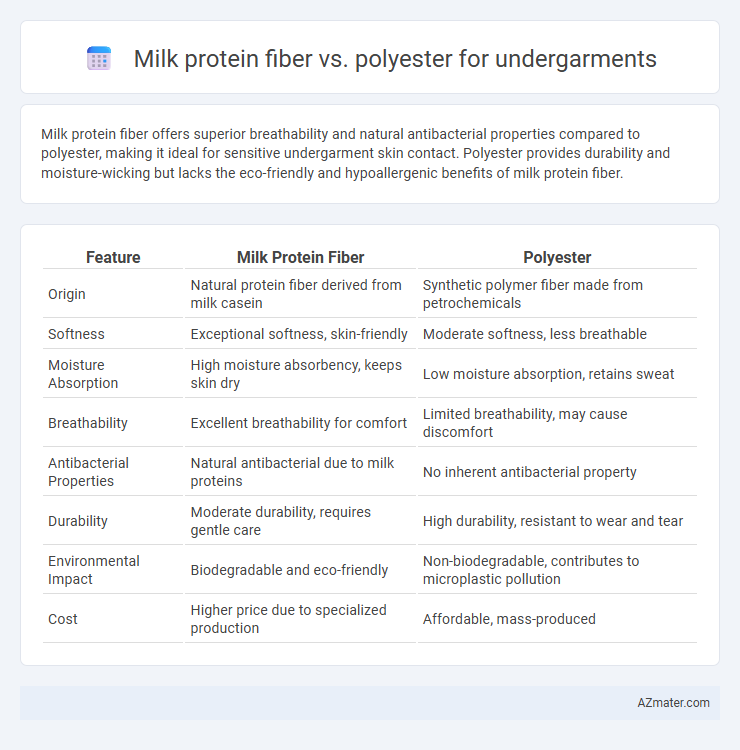Milk protein fiber offers superior breathability and natural antibacterial properties compared to polyester, making it ideal for sensitive undergarment skin contact. Polyester provides durability and moisture-wicking but lacks the eco-friendly and hypoallergenic benefits of milk protein fiber.
Table of Comparison
| Feature | Milk Protein Fiber | Polyester |
|---|---|---|
| Origin | Natural protein fiber derived from milk casein | Synthetic polymer fiber made from petrochemicals |
| Softness | Exceptional softness, skin-friendly | Moderate softness, less breathable |
| Moisture Absorption | High moisture absorbency, keeps skin dry | Low moisture absorption, retains sweat |
| Breathability | Excellent breathability for comfort | Limited breathability, may cause discomfort |
| Antibacterial Properties | Natural antibacterial due to milk proteins | No inherent antibacterial property |
| Durability | Moderate durability, requires gentle care | High durability, resistant to wear and tear |
| Environmental Impact | Biodegradable and eco-friendly | Non-biodegradable, contributes to microplastic pollution |
| Cost | Higher price due to specialized production | Affordable, mass-produced |
Introduction to Milk Protein Fiber and Polyester
Milk protein fiber is a biodegradable textile made from casein, offering softness, breathability, and natural antibacterial properties ideal for sensitive skin. Polyester, a synthetic fiber derived from petrochemicals, provides durability, moisture-wicking capabilities, and resistance to wrinkles and shrinking in undergarments. Comparing these, milk protein fiber excels in comfort and eco-friendliness, while polyester is favored for strength and easy care.
Origins and Production Processes
Milk protein fiber, derived from casein proteins found in milk through a wet spinning process, is a natural and biodegradable textile known for its softness and moisture-wicking properties. Polyester, a synthetic fiber produced from petrochemicals via polymerization of ethylene glycol and terephthalic acid, offers durability and wrinkle resistance but relies heavily on fossil fuels. The contrast in origins--natural milk protein versus petroleum-based polyester--significantly impacts the environmental footprint and sustainability of undergarment fabrics.
Comfort and Texture Comparison
Milk protein fiber offers superior softness and breathability compared to polyester, making it ideal for undergarments worn close to the skin. Its inherent moisture-wicking and antibacterial properties enhance comfort by reducing irritation and odor. Polyester, while durable and moisture-resistant, often lacks the plush texture and natural feel provided by milk protein fiber, which contributes to a more pleasant wearing experience.
Breathability and Moisture Management
Milk protein fiber boasts superior breathability compared to polyester, allowing better air circulation and keeping the skin cooler during wear. It excels in moisture management by absorbing and releasing sweat efficiently, reducing discomfort and odor buildup. Polyester, while durable, tends to trap heat and moisture, making it less ideal for undergarments that prioritize comfort and freshness.
Allergenicity and Skin Sensitivity
Milk protein fiber, derived from casein in milk, exhibits excellent hypoallergenic properties and is gentle on sensitive skin due to its natural protein composition and moisture-retaining abilities. Polyester, a synthetic fiber, often causes irritation and allergic reactions in individuals with sensitive skin because it lacks breathability and traps moisture, leading to bacterial growth. Choosing milk protein fiber for undergarments can reduce allergenicity and enhance comfort for people prone to skin sensitivities.
Durability and Longevity
Milk protein fiber exhibits excellent durability due to its natural protein structure, which provides resistance to wear and maintains fabric integrity over time. Polyester, a synthetic fiber, offers superior tensile strength and abrasion resistance, resulting in longer-lasting undergarments that withstand frequent washing without significant degradation. Both materials perform well in longevity, but polyester tends to retain shape and color more effectively under extended use.
Sustainability and Environmental Impact
Milk protein fiber, derived from renewable casein protein in milk, offers superior biodegradability and a lower carbon footprint compared to polyester, which is petroleum-based and contributes significantly to microplastic pollution. The production of milk protein fiber involves less energy consumption and emits fewer greenhouse gases, while polyester manufacturing relies heavily on fossil fuels and generates non-biodegradable waste. Choosing milk protein fiber for undergarments supports circular economy principles and reduces environmental impact by enabling easier recycling and natural decomposition.
Care and Maintenance Requirements
Milk protein fiber undergarments require gentle washing with mild detergents and low-temperature settings to preserve their softness and natural antibacterial properties. Polyester undergarments are more durable, tolerating higher temperatures and regular machine washing without significant damage or shrinkage. Proper care of milk protein fiber extends garment lifespan but demands more delicate handling compared to the low-maintenance nature of polyester.
Cost Analysis and Market Availability
Milk protein fiber undergarments typically cost more than polyester options due to the complex manufacturing process and limited scale of production. Polyester is widely available and produced at a lower cost, benefiting from mature supply chains and extensive market penetration. Consumers seeking eco-friendly and skin-friendly alternatives often face higher price points with milk protein fiber, while polyester offers affordability and easy accessibility in mass markets.
Final Verdict: Which is Best for Undergarments?
Milk protein fiber offers superior moisture absorption, breathability, and antibacterial properties compared to polyester, making it ideal for sensitive skin and all-day comfort in undergarments. Polyester excels in durability, wrinkle resistance, and cost-effectiveness but lacks the natural softness and skin-friendly benefits of milk protein fiber. For undergarments prioritizing comfort, hygiene, and sustainability, milk protein fiber is the better choice, while polyester suits budget-conscious consumers seeking long-lasting wear.

Infographic: Milk protein fiber vs Polyester for Undergarment
 azmater.com
azmater.com